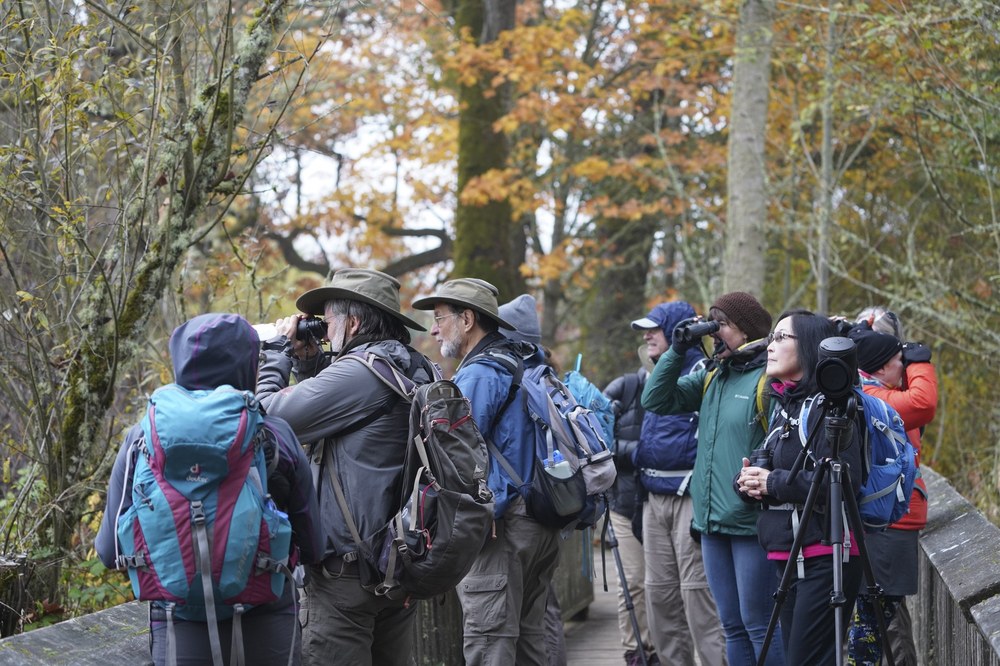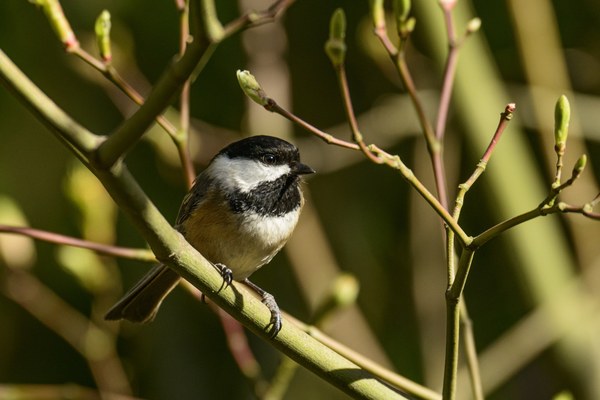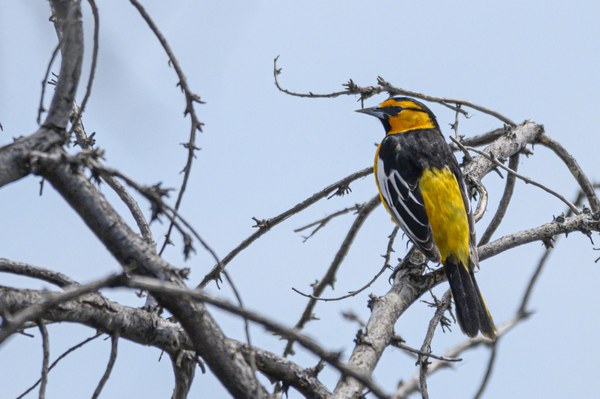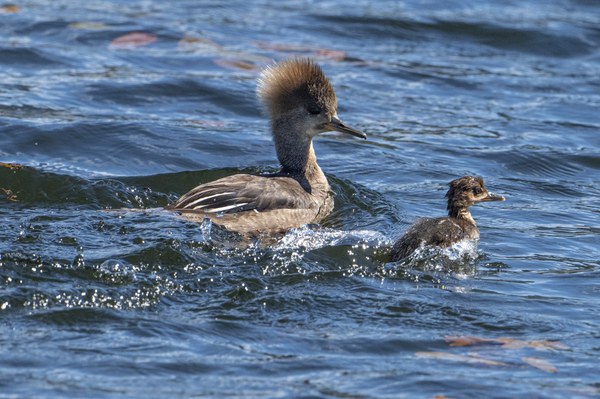
The Black-capped Chickadee flitted through the fir branches. It was about the size of two ping-pong balls, and nimble – it twisted, turned, and darted through my Seattle neighborhood. This bird is common across much of North America and always brings a sense of joy each time I see one. In fact, it may be one of the first birds I learned to identify when my mother caught me sitting in the kitchen sink, watching birds coming to her feeders. I was five, and she patiently stood behind me naming each species. Almost 65 years later I remain delighted by these incredible creatures, and I would like to share with you some of the lessons I have learned in my many (well-spent) years of birdwatching.
Why choose birding?
Curiosity and patience are the only prerequisites to birding. It’s a hobby that can be done anywhere; out the kitchen window, in your neighborhood, or on a backpacking trip into the backcountry. Most birds are out in the day, and they occur in all habitats; busy cities, wild deserts, oceans, and from valleys to mountaintops. I’ve watched Pied-billed Grebes and Buffleheads dive for food in the little ponds at Magnuson Park, Dark-eyed Juncos sing from branches sticking over the meadows at St. Edwards Park, and American Pipits feed in the alpine meadows of Mt. Baker. As a birder, I know there is always more to see and something new around the next corner. One spring in Umtanum Canyon, a hen turkey shot out from behind a shrub and began to charge us. She spread her wings and darted toward us before running off, squawking and flapping her wings. We had inadvertently scared her off her nest, and left quickly so she could return to her mothering. Being able to identify and understand these animals adds an entirely new dimension to our time outdoors.
 A Black-capped Chickadee in Seward Park. Photo by Thomas Bancroft.
A Black-capped Chickadee in Seward Park. Photo by Thomas Bancroft.
Tools of the trade
One of the best parts of birding is the ease of entrance; a pair of binoculars and a method of identification are all you need to get started. A seven or eight-power pair is perfect, as more power can make it harder to hold the binoculars still. Audubon’s nature shops or an outdoor retail shop will often have multiple kinds to let you get a feel for what works best for you. For instance, glasses wearers should find binoculars that work with them.
A good bird book and the Merlin App for smartphones will get you far. Books come in many forms; some use paintings, others drawings or photographs, and they often present the characteristics to check in different ways. The most important thing is to pick one that works for you. Another big decision is choosing a national or regional birding book. For a starter book I often recommend one for the west, because it will be focused on just the birds west of the Mississippi. Peterson and Sibley make popular western ones, and regional ones by John Shewey or Tom Aversa are good too.
Available for both iPhone and Android, the Merlin app is free and produced by the Cornell Laboratory of Ornithology. The app is interactive and very helpful to new birders developing their identification skills. Cornell has produced bird identification packs for most of the world, making Merlin an excellent travel partner.
Key tips
It’s easy to be overwhelmed with the vast numbers of birds found in the northwest, each with a different set of plumages, calls, and behaviors. Here are a few tips to keep in mind to start you out on the right foot:
See past the feathers
Top birders don’t focus on the fine details of a bird’s plumage. Rather, they focus on five characteristics: size and shape, color patterns, behaviors, habitat, and sounds. They try to find at least three things out of these, though more is better. Behaviors such as how they fly, how they feed, and what they eat are all unique to the lifestyle of a species. Similarly, birds must make a living and are therefore often tied to a habitat – forests, wetlands, grassland, shorelines, or oceans - for all their needs. For example, when visiting Discovery Park in Seattle or Marymoor Park in Redmond, I look for Savannah Sparrows giving their three-part song from a grass stem in the fields, Spotted Towhees and Song Sparrows flicking dead leaves under bushes, or Pacific Wrens belting out their songs - a tumbling series of trills - in the dense woods. Size and shape can separate birds into groups. Many birds can even be identified from a silhouette alone.
 A Bullock’s Oriole in Moses Lake. Photo by Thomas Bancroft.
A Bullock’s Oriole in Moses Lake. Photo by Thomas Bancroft.
Mistakes are okay
New birders should not fear making mistakes in identification. I still make errors, and I’ve been doing this all my life. On a field trip for a class last winter, I identified five birds on the breakwater near Edmonds Pier as Rock Sandpipers. That evening when I looked at my photographs, they were all Surfbirds - a different sandpiper. Embarrassed, I projected the images in the next class and showed everyone my error. We laughed and learned together.
Start slow & have fun!
My final advice for birding is to go slowly and not to put pressure on yourself to identify everything. Sometimes just identifying the group to which a bird belongs is perfect. You might recognize that it’s a sparrow, warbler, or duck, and that’s a great start. Bird with other people when you get a chance. We all see the world in different ways; learn from them.
Start with local birds in your neighborhood or a nearby park and expand out as your confidence and interest grow. A trip to a National Wildlife Refuge such as Nisqually, Protection Island, or Columbia will add many species of ducks, shorebirds, and others. I’ve backpacked into subalpine lakes in the North Cascades to look for winnowing Wilson’s Snipe and singing Hermit Thrushes. A summer trip to Sinlahekin or Okanogan can add species like Yellow-breasted Chat, Eastern & Western kingbirds, calling loons, and breeding goldeneyes. Friends that mountain climb tease me that they’ve seen Gray-crowned Rosy-Finches, a bird of the high elevations, on their ascents of Mt. Rainier or Baker.
I’ve been an ornithologist my entire life, but I still feel like a little kid when I see birds. These little feather balls offer a view onto the natural world, revealing things you may not have otherwise seen. Throughout the Stay at Home order I watched birds out my windows, in my yard, and on neighborhood walks. I began to expect certain birds at particular places, like the junco singing from my neighbor’s dormer, the crow greeting me when I stepped out to fill the feeders, or the chickadee giving his “Hey Sweetie” song by the neighborhood playground. As spring came, I started to look for Western Tanagers, Yellow Warblers, and Black-headed Grosbeaks that had spent the winter farther south. As summer approached, I anticipated recently-fledged juncos, finches, and bushtits visiting my feeders. With fall others have come, as the ducks that moved far north to breed return to Washington, the Hermit Thrushes that went up into the mountains for the summer move to lower elevations, and the Snow Geese from the Arctic winter in the Skagit. The orioles, tanagers, and many of the warblers will head south, leaving Washington until the next spring. Birds deliver a lifelong journey of discovery, learning, joy, and solace. I encourage you to take the first step into their incredible world.
 A Hooded Merganser in Okanogan County. Photo by Thomas Bancroft.
A Hooded Merganser in Okanogan County. Photo by Thomas Bancroft.
Thomas Bancroft is career biologist, ornithologist, photographer, and former Chief Scientist for the National Audubon Society. You can see his photography at thomasbancroft.com, or look for one of his birding courses on our website.
This article originally appeared in our Fall 2020 issue of Mountaineer Magazine. To view the original article in magazine form and read more stories from our publication, visit our magazine archive.
 Thomas Bancroft
Thomas Bancroft